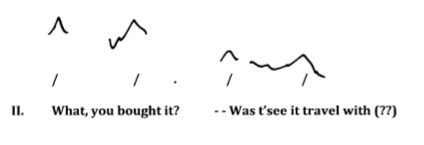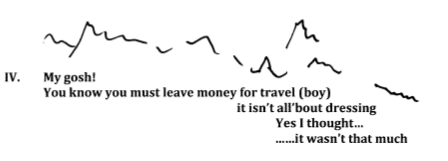TUTORIAL for the HANDBOOK FOR
ACOUSTIC ECOLOGY

|
SPEECH ACOUSTICS
|
Interpersonal
Dialogue
In any interpersonal dialogue, paralanguage, along
with other non-verbal cues, creates, reflects and reinforces a
relationship between the people involved. If they are meeting
for the first time, there is an implied distance, but also
perhaps cues to suggest a friendly narrowing of that distance,
or at least to negotiate that option to see if the invitation
will be accepted.
When a power imbalance is present in an interpersonal
relationship, the paralanguage will likely reinforce that
difference with a more formal type of interaction, a setting
of boundaries, a lack of negotiation and maintenance of
non-verbal differences. However, in a more progressive and
open-ended situation, the one with the greater power, such as
a teacher, may attempt to break down those differences by
giving non-verbal cues that such formalities are not
necessary, and co-operation, for instance, is possible.
With good friends, a lot of the interpersonal communication
will likely be designed to reinforce the existing
relationship, assuming it is satisfactory to both parties. The
paralinguistic cues will likely be designed to match each
other. In an interview situation, where you are meeting
someone for the first time and want to elicit what is genuine
for them to reveal, it is wise to match their paralinguistic
cues, to allow their pauses, to react to what they have to say
in a respectful manner.
Family situations are often the most complex, if not downright
complicated situations for interpersonal dialogue, as all of
the tendencies and strategies mentioned already can be
involved at a non-verbal level. Moreover, everyone involved
knows how to instantly interpret the paralinguistic cues and
negotiate their response.
Here is an example of interpersonal negotiation between a son
and his mother (joined at the end by the father), that
occurred in under 25 seconds with four back-and-forth
interactions where the paralinguistic cues and responses
shifted in each interaction. It is a bit difficult to hear the
first time round, because of background voices, but at SFU, we
developed a technique of looping each interaction so
that the paralinguistic contours could be easily identified.
This technique is similar to what psychologist Diana Deutsch
termed “speech
to song” over a decade later in the 1990s. By
looping a phrase, its song-like qualities become
readily apparent, which means that the paralanguage of pitch
inflection, stress patterns and rhythms become more obvious,
with less attention needing to be devoted to the verbal
content.
We will call this a mini-opera in four acts, and present each
interaction separately with four repetitions of the vocal
sound, a rough outline of the pitch and rhythmic inflections
as related to the text, and a detailed spectral representation
of the recording.
Act One.

First
interaction
|

Click
to enlarge |
In this
initial interaction, the mother asks a relatively neutral
question about where her son got the jacket he is wearing,
putting the emphasis on “jacket” with a slight rise in pitch.
After two beats of silence, the son mumbles something about
getting it a few days ago. The paralanguage between the two
couldn’t be more different. She speaks clearly in an upper
middle register with normal loudness, while he speaks in a
lower register, slurs his words and can barely be heard. She
asks “where”, he replies “when”. Combined with the two beats
of silence, his strategy clearly is: deflect the question.
Maybe he guesses where this is leading.
Act Two.

Second
interaction
|

Click
to enlarge |
In the
second interaction, the mother acts surprised with an
exclamation of “What” on a very high pitch, much louder than
before, followed by the simple question “you bought it?”. The
paralanguage now makes it clear what the issue is. The stress
is not on “you bought it” (as in, you never buy your
own clothes), nor is the stress on “you bought it”
(meaning the jacket is not to her liking). No, the stress is
on “you bought it” with the word “bought” landing on
the beat. It’s doubtful she thought he might have borrowed or
stolen it, so the issue is clearly the money involved.
The son this time waits only one beat, raises his pitch and
loudness level, and improves his articulation somewhat to
offer a defence that the jacket is intended for travel. The
loop makes it clear that he is closing the gap between their
vocal styles, as he says this in the same rhythm as the
mother, putting the word “travel” on the same beat she has
established. The strategy now is: offer a plausible
defence.
Act Three.

Third interaction
|

Click
to enlarge |
At this
point, since neither is backing down, in the third interaction
they decide to match each other’s paralanguage in a perfectly
co-ordinated “song” with four beats. The key words fall
precisely on the beat – “bought/jacket/travel” – with the
final "yeah" on the syncopated half beat for emphasis, and no
pause between their two phrases. Their pitch and loudness
match each other as much as possible (she lowers hers, he
raises his), and the articulation of the words is very clear.
They are now in harmony, so to speak, sounding as
equals.
Act Four.

Fourth interaction
|

Click
to enlarge |
However,
the harmony is short-lived, as the father joins the
conversation and together with the mother they overwhelm their
son, again emphasizing the issue of money. The son has no
option but to retreat, and return to his initial low-pitched,
low-level, slurred speech, tossing in a final “it wasn’t that
much” as a final cadence. Here is the complete set of
interactions, taking a mere 22 seconds.
Complete
conversation
We won’t
speculate further on the family dynamics (including why the
parents didn’t know about the jacket until they were
together at a party). What is remarkable – though not
atypical in any way – is the speed of the paralanguage
shifts and the economy of the actual text being used. This
must be the result of their long-term experience of
interacting as a family, complete with underlying tensions
and evolving roles, all of which is reflected in the
non-verbal type of behaviour we have experienced here.
Use the back button or return to the module index.

